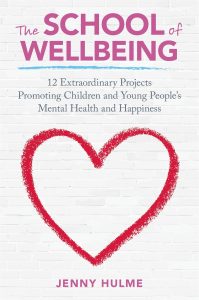 Jenny Hulme, author of The School of Wellbeing, discusses her new book and the projects she’s explored that support students’ emotional wellbeing. At a time when the state of young people’s mental health is being recognised as central to their learning and attainment, her book gives unique insight into these projects and features the education leaders and charities behind them, including Place2Be, Kidscape, Beat and more.
Jenny Hulme, author of The School of Wellbeing, discusses her new book and the projects she’s explored that support students’ emotional wellbeing. At a time when the state of young people’s mental health is being recognised as central to their learning and attainment, her book gives unique insight into these projects and features the education leaders and charities behind them, including Place2Be, Kidscape, Beat and more.
When I started writing this book a year ago, the media were talking, ever more urgently, about the epidemic of young people at odds with the world around them. Research was suggesting rates of depression were rising in primary schools and anxiety among teenagers had increased by 70 per cent in the past 25 years. Meanwhile, reports noted the rapid rise in hospital admissions for young people with eating disorders. Every story posed more questions than answers about the role of everything from poverty to education policy, exam stress to social media. Other more recent headlines included news of a 14 per cent rise in teenagers being admitted to hospital after self-harming, with the NSPCC saying they delivered thousands of counselling sessions on self-harm last year (as many as 50 a day) via Childline. It was heartening to read at the same time talk of the Government making relationships and sexual health a statutory subject to tackle the problem of sexual harassment and sexting in schools. But developments like this come not a moment too soon.
Given what teachers are dealing with in schools today, including their own workplace stress, and how long and hard they’ve been shouting out about these problems, it would be easy for them to feel overwhelmed and powerless to effect change. That’s not what I found, though. What schools and educational charities showed me as I was writing this book is that there is, actually, plenty that can be done right here and now – this term, this week – that, even if not a complete solution, can make a difference.
These schools told me about the power of collaboration with charities, experts, each other, the pupils themselves and their parents. They shared with me the importance of thinking outside the box; beyond the pressures of timetables and testing. By starting conversations about inclusion, equality, relationships, social media and academic pressure, these schools have recognised the need to place mental health at the forefront of their work.
Crucially, the schools were unanimously confident in their knowledge that unless children are happy, befriended, supported, and secure they won’t learn anyway. In fact many were already finding that when they dared to take risks (and their eye off league table places or results) and put emotional wellbeing first, positive results surely followed, equipping young people with the confidence to succeed as they move into work or further education.
This book shares their stories.
It introduces mentoring schemes that give children, struggling as they start secondary school, the confidence to build friendships, attend social activities, and the desire to come to school. Attendance and attainment soared as a result. The book shows how involving parents in the school journey can be transformative, recognising them as a crucial part in the learning process by acknowledging their insight into their child’s needs, and involving them in learning targets. It visits Lego Clubs that are giving children with communication difficulties the skills to prevent isolation both at school and as teenagers moving into the world of work. It introduces the power of poetry to open up conversations about issues like bullying and loneliness, and it discusses the advantages of a simple daily run around the playground that, when slipped into the school day, can bring benefits that last long after children are back at their desks. The schools embraced the life-changing force of counsellors, role models and the all-crucial role of PSHE, whilst those that had revisited their anti-bullying policies were able to demonstrate a kind and equitable school culture. This was built upon a whole school approach to an issue that is responsible for creating, and exacerbating, many mental health problems.
The schools told me over and over just how resilient children can be – even those who have been through the toughest of experiences in their early life – and shared the belief that small, practical initiatives can enrich the lives not just of students who are struggling, but of everyone in the school. Not one of them talked about children beyond help.
Schools face an enormous challenge today, but these projects often started small, and grew and are still growing with the help of the pupils, staff, parents and community at large. And once they started, there was no one who wanted them to stop. It has been a complete privilege to share a few of them in this book.
I’d love to hear what you think, and about what your school is doing that I can share with others in the future. @hulmejenny #SchoolofWellbeing